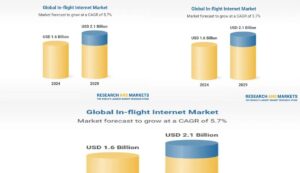In-Flight WiFi Market to BOOM 57% by 2029: Passengers Demand High-Speed Connection!
Passengers crave in-flight WiFi! The market is set to soar 57% by 2029 with airlines offering faster connections to stay competitive. Expect better WiFi on long-haul flights, especially in North America.
CONTENTS: In-Flight WiFi Market to BOOM 57% by 2029

Inflight WiFi: Growing Demand, Global Reach
In-Flight WiFi Market to BOOM 57% by 2029
ResearchAndMarkets.com has introduced a new report titled “Global In-flight Internet Market by Technology (Air-2-Ground, Satellite, Hybrid), End User (Commercial Aviation and Business Aviation), Service Model (Free, Paid, Freemium), Connectivity Speed and Region – Forecast to 2029.” The report projects that the In-flight Internet market will grow from USD 1.6 billion in 2024 to USD 2.1 billion by 2029, with a compound annual growth rate (CAGR) of 5.7% during this period.
As air travel becomes more globalized and flight durations increase, the need for passengers to stay connected on long-haul flights intensifies. In-flight Wi-Fi is emerging as the key solution, providing continuous connectivity on international routes.
Additionally, the expansion of satellite communication infrastructure plays a crucial role in this connectivity transformation. With the development of more ground stations and enhanced satellite coverage in various regions, it is becoming easier and more cost-effective for airlines to offer in-flight Wi-Fi services, catering to the evolving needs of modern travelers around the world.
Faster WiFi, Airlines Up Revenue
In-Flight WiFi Market to BOOM 57% by 2029: The report indicates that the commercial aviation segment is anticipated to hold the largest market share in 2024. In-flight Wi-Fi serves as a significant ancillary revenue stream for commercial airlines, which leverage connectivity through various monetization strategies such as tiered pricing, subscription services, and advertising.
The potential for additional revenue provides a compelling reason for airlines to invest in advanced Wi-Fi infrastructure, recognizing the financial benefits of catering to passengers’ connectivity demands.
Regarding connectivity speed, the Electric GSE segment is projected to experience the highest growth during the forecast period. The advancement and deployment of high-capacity satellite networks, coupled with improved onboard Wi-Fi systems, have enabled airlines to offer high-speed internet services.
These networks can efficiently support more users and provide faster connections, thereby facilitating the expansion of high-speed offerings. Airlines equipped with high-speed Wi-Fi gain a competitive edge, particularly among tech-savvy and discerning passengers who prioritize connectivity quality when choosing an airline.
North America Leads Inflight WiFi Market
In-Flight WiFi Market to BOOM 57% by 2029: North America features prominent airlines such as American Airlines, Delta Air Lines, and United Airlines, which consistently upgrade their fleets with advanced in-flight connectivity technologies.
The region’s extensive network of frequent and long-haul flights underscores the significance of in-flight connectivity, offering ample opportunities for passengers to utilize and value Wi-Fi services. Moreover, competition within North America’s airline industry drives carriers to prioritize superior in-flight services, including Wi-Fi, to attract and retain customers. This competitive environment encourages ongoing investments and improvements in in-flight connectivity to meet evolving passenger expectations.
In terms of end users, the in-flight internet market is segmented into commercial aviation and business aviation. The technology segment includes air-to-ground, satellite-based, and hybrid solutions. Connectivity speed is categorized into high-speed, standard, and low-bandwidth options. Service models encompass free, paid, and freemium offerings.
The report divides the in-flight internet market across six key regions: North America, Europe, Asia Pacific, the Middle East, and the Rest of the World, with detailed insights into drivers, challenges, opportunities, and other significant factors influencing market growth.
It also provides a comprehensive analysis of major industry players, including Viasat, Inc., Gogo Business Aviation LLC, Panasonic Avionics Corporation, Thales, and Collins Aerospace, highlighting their business profiles, solutions, services, and key activities such as agreements, product launches, expansions, acquisitions, and partnerships across global regions.
Inflight WiFi Market: Growth, Tech Advance, Global Reach
– Number of Pages: 218
– Forecast Period: 2024-2029
– Estimated Market Value (USD) in 2024: $1.6 Billion
– Forecasted Market Value (USD) by 2029: $2.1 Billion
– Compound Annual Growth Rate: 5.7%
– Regions Covered: Global
Premium Insights:
– Increasing demand for internet services to enhance passenger experience will drive market growth.
– Satellite-based segment is expected to hold the largest market share during the forecast period.
– Paid Wi-Fi segment is projected to dominate during the forecast period.
– UAE is anticipated to register the highest CAGR during the forecast period.
Drivers:
– Increasing demand for connectivity
– Airlines leveraging superior in-flight internet services
– Growth in long-haul flights
– Deployment of advanced Ku-band and Ka-band satellites
Restraints:
– High initial installation and maintenance costs
– Bandwidth limitations
Opportunities:
– Expansion into emerging markets
– New revenue streams for airlines and service providers
– Development of Low Earth Orbit (LEO) satellite technology
Challenges:
– Complex installation processes
– Viability of service quality
Technology Trends:
– Adoption of Low Earth Orbit (LEO) satellites
– Integration of 5G onboard systems
– Multi-link connectivity solutions
Technology Analysis:
– Key technologies include satellite communication systems, air-to-ground networks, and antenna technologies.
– Complementary technologies focus on bandwidth optimization, cybersecurity solutions, and passenger experience platforms.
– Impact of megatrends such as Artificial Intelligence (AI), Machine Learning (ML), Big Data & Analytics, connectivity, and digitalization.
Companies Featured:
The report covers prominent companies like Viasat, Inc., Gogo Business Aviation LLC, Panasonic Avionics Corporation, Thales, Collins Aerospace, Anuvu, Safran, Intelsat, Iridium Communications Inc., Starlink, Hughes Network Systems, LLC, Eutelsat Communications SA, AeroMobile Communications Ltd., Asia Satellite Telecommunications Co. Ltd., SITA, Deutsche Telekom, T-Mobile US Inc., Thaicom PLC, AirFi, G-Connect, JSAT Mobile Communications, SkyFive, SES SA, Telesat, and Avanti Hylas 2 Limited.
Check out TimesWordle.com for all the latest news
You must be logged in to post a comment.